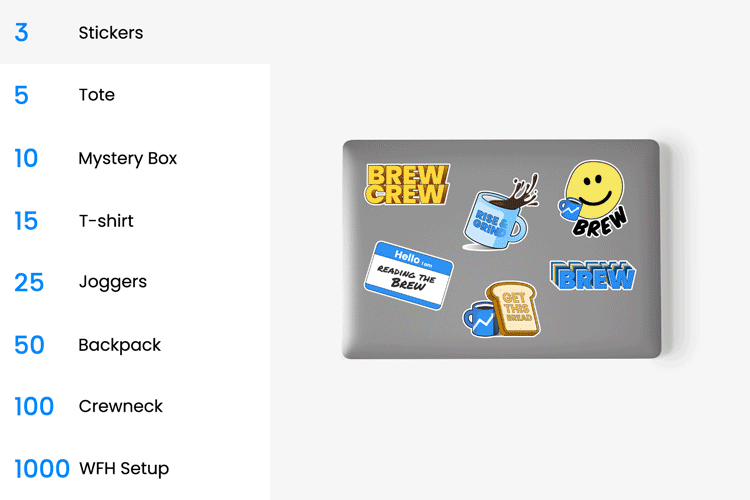It’s Friday. Good news for anyone who routinely shouts at a speaker to set a timer or play a (Taylor’s Version): Google and Amazon are allowing their voice assistants to coexist on the same smart speaker, introducing the possibility of doubling your digital help. Houses divided—you know those couples where one person has an iPhone and the other has an Android? Madness!—shall remain so.
In today’s edition:
—Maeve Allsup, Patrick Kulp, Kristen Parisi, Annie Saunders
|
|
Illustration: Francis Scialabba, Photo: JBL
Amazon Alexa and Google Assistant may soon be tag-teaming their roles as kitchen DJ or in-home meteorologist.
The tech giants announced this week that a forthcoming line of speakers—Harman’s JBL Authentics 200, 300, and 500—will be able to host both voice assistants simultaneously.
While previous devices required users to choose between different voice platforms, the move marks the first time multiple assistants can coexist, according to the companies.
That functionality lets users toggle between features from each assistant—Google’s search or Amazon’s shopping, for instance—or tap a new directive called Universal Device Commands (UDC) to end an action, allowing users to, essentially, command that the speaker knock it off, regardless of which assistant initiated the action (think timers and music).
While device makers and tech giants have long discussed voice interoperability as a possibility, technical hurdles and issues of company coordination stood in the way.
When it came to pairing up Alexa and Google Assistant, technical challenges included using hardware and components designed to work with both assistants, developing software rules that ensure the voices won’t talk over each other, and ironing out UDC mechanics across both platforms, according to Mark Yoshitake, GM and director of Alexa developer technologies and experiences.
“Typically, we’re integrating a single assistant on a single device with components like microarrays and chipsets that are made with the idea of a single assistant,” Yoshitake said. “Making both of those work really well with the right type of memory footprints, optimizing those things, making sure the latency and the overall experience felt really snappy, was definitely something that we really focused on.”
Keep reading here.—PK, MA
|
|
How? With Morning Brew’s engaged audience of 22m+ monthly readers, of course.
Our unique community of young, hard-to-reach readers (who are 1.7x more likely to have a household income of $150k+) can give your B2B offerings the valuable visibility you’re looking for.
B2B decision-makers know how crucial it is to get their business’s potential in front of the right  s, and the Brew’s paid advertising opportunities connect your brand to our audience by leveraging our popular B2B-centric franchise newsletters, specialized events, and skyrocketing cache of multimedia content. s, and the Brew’s paid advertising opportunities connect your brand to our audience by leveraging our popular B2B-centric franchise newsletters, specialized events, and skyrocketing cache of multimedia content.
Morning Brew is powered by the knowledge our readers trust us to deliver. From Retail Brew’s trending insights to Healthcare Brew’s timely updates, we’ve got a B2B Brew for you. Which one will you choose to grow with?
Advertise with us.
|
|
Sweetbunfactory/Getty Images
Chip design firm Arm is prepping to strut out onto the public markets at a moment when the semiconductor industry is in flux.
The boom around AI is providing a bright spot in a market otherwise mired in a supply glut that followed a pandemic-driven shortage. SoftBank Group-backed Arm, which recently filed paperwork for what is expected to be the biggest tech public offering of the year, is riding a rebound in chip demand, according to Forrester VP and Research Director Glenn O’Donnell.
“The semiconductor world has been in a funk lately, for the last maybe two years,” O’Donnell said. “The semiconductor market is on a rebound. And, of course, the best time to get in on that is at the bottom, and we’re just coming off the bottom. So I think it’s a pretty good move.”
The Arm alternative: Arm has carved out a space in the industry as an alternative to Intel’s x86 architecture and AMD, which have dominated the market for years, according to O’Donnell.
Apple, which has a long history of working with Arm, has expanded its partnership with the firm over the last couple years with the transition from Intel to its own Arm-based silicon chips. Microsoft and Google are also working on more processors “using building blocks licensed from Arm,” according to the Wall Street Journal.
“Intel’s x86 is still king of the hill. But Arm represents an interesting and potentially exciting alternative that a lot of companies are pursuing,” O’Donnell said.
Keep reading here.—PK
|
|
The Jetsons/ABC via Giphy
When envisioning a tech-enabled assistant, Gen X and elder millennials may picture Rosey from The Jetsons. Sadly, robotic housekeepers aren’t real—but Walmart’s new generative AI tool aims to help corporate associates do their jobs better.
The tool, called My Assistant, officially launched August 30. Walmart’s EVP and chief people officer, Donna Morris, recently told HR Brew what it will mean for employees and, in the future, HR professionals.
What it is: My Assistant is a desktop and mobile app available to Walmart’s US corporate associates, according to a LinkedIn post announcing its availability. The tool, powered by generative AI and developed by Walmart, is meant to help employees do some aspects of their jobs, like drafting and summarizing documents or cutting repetitive tasks.
Morris was quick to point out that My Assistant won’t replace any workers.
“This has everything to do with making our associates productive, and enhancing the quality of work that they are doing,” Morris explained to HR Brew. “We continue to see opportunities for us to really leverage [generative] AI as it relates to things like onboarding associates, finding benefit information, making connections, supporting their growth and development, which today can be very cumbersome.”
Keep reading here.—KP
|
|
|
Let’s talk money. If you like your financial advice with a side of (all in good fun) roasting, then you need Cleo—the world’s first AI-based personal finance assistant. The burns may be sick, but 71% of users feel more optimistic about their long-term financial futures after using Cleo. Get roasted.
|
|
Zgel/Getty Images
Usually, we write about the business of tech. Here, we highlight the *tech* of tech.
Screen stress: If you’re like us (and we assume you are, having gotten all the way to the bottom of a newsletter called Tech Brew), you spend a goodish bit of your day with your eyeballs trained directly on a screen. And if that’s the case, you’ve probably considered that it might be…not great. Would Apple bother to install an app on your phone that tracks your steps if it weren’t bad for your health to take too few? Would it add an app to count your screen-to-face minutes if it weren’t undesirable for you to have too many?
“Apple introduced Screen Time as a built-in app in 2018 with the release of iOS 12, after major investors requested a tool that would help the company consider the effects of screen time on children’s mental health,” Sarah Hagi wrote in Wired.
She argues that if you’re a grownup, it’s maybe time to stop worrying about it, and we have to agree. We’d not know conversational German were it not for Duolingo! It’s hard to come by a physical newspaper in some cities! And we’d be terrible at raising children without access to the well-credentialed parenting experts offering advice on Instagram.
But that’s not to say that all your screen time must be spent in pursuit of self-improvement. “I will always feel some self-reproach when I spend all day being unproductive or avoidant, but those days would exist with or without my phone. Being ‘bad’ is just a part of being alive,” Hagi wrote.
Amen. Enjoy your long weekend, and don’t be so hard on yourself about your screen time, OK?
|
|
|
Share Tech Brew with your coworkers, acquire free Brew swag, and then make new friends as a result of your fresh Brew swag.
We’re saying we’ll give you free stuff and more friends if you share a link. One link.

Your referral count: 2
Click to Share
Or copy & paste your referral link to others:
emergingtechbrew.com/r/?kid=303a04a9
|
|
|
Written by
Maeve Allsup, Patrick Kulp, Kristen Parisi, and Annie Saunders
Was this email forwarded to you? Sign up
here.
 Guide →
What is AI?
Guide →
What is AI?
 Guide →
What is 5G?
Guide →
What is 5G?
Take The Brew to work
Get smarter in just 5 minutes
Business education without the BS
Interested in podcasts?
|
ADVERTISE
//
CAREERS
//
SHOP 10% OFF
//
FAQ
Update your email preferences or unsubscribe
here.
Please Note: We've recently updated our Privacy Policy. View our privacy policy
here.
Copyright ©
2023
Morning Brew. All rights reserved.
22 W 19th St, 4th Floor, New York, NY 10011
|
|








